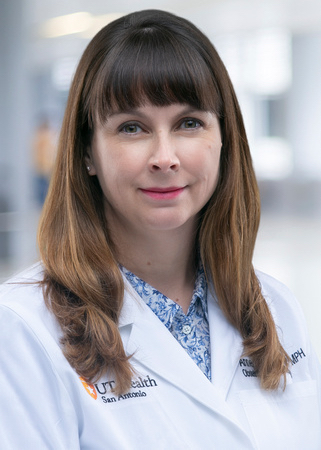By Paul J. Watkins

Endometriosis is a very common condition that develops in women during childbearing years. According to Belinda Yauger, MD, who is dual board certified in obstetrics and gynecology and in reproductive endocrinology and fertility, endometriosis is a disease where the endometrial tissue that normally lines the uterus starts to implant and grow in other places.
“It can implant on the ovaries, fallopian tubes, intestines, wall of the pelvis, bladder, diaphragm, lungs, and several other places,” says Dr. Yauger, who sees patients at UT Health Physicians. “If it implants and starts to grow, that’s when endometriosis develops.”
Anne Porter, MD, a board-certified OB-GYN who also practices at UT Health Physicians, notes that when women exhibit symptoms of endometriosis, the most common is pain. It can accompany the menstrual cycle or occur outside of the menstrual cycle, and the pain is usually located in the pelvis, lower pelvis, or abdomen. Women may also experience pain with intercourse, urination, or defecation.
“Today, the primary medical treatment for endometriosis is hormonal suppression,” informs Dr. Porter. “The endometriosis cells are the normal glandular tissue that lines the uterine cavity, so they respond to the normal
hormones of a woman’s menstrual cycle – estrogen and progesterone. One of the primary treatments is to suppress those hormones, which will then suppress the activity of the endometriosis lesions.”
“The mainstay of hormonal suppression is birth control pills or progesterone treatment,” notes Dr. Yauger, “as well as occasionally using a medication called leuprolide, which causes a more profound suppression in the estrogen and progesterone levels. Leuprolide is used as an injectable medication. More recently, an oral medication has been developed that is similar to leuprolide, which can also cause hormonal suppression. Other treatments, such as ibuprofen and naproxen, can be used in conjunction to treat pain. These are the most common medical treatments at this point in time.”
“For many women who aren’t candidates for medication, prefer not to take medication, or have tried and failed medication, surgery is the next step,” states Dr. Porter. “It can be surgery that removes the endometriosis and leaves the uterus in place, or it can be surgery to remove both the endometriosis and the uterus. In some cases, we’ll remove the endometriosis, uterus, and ovaries. I typically recommend retaining ovaries in young women because I think that we can get an effective response with hysterectomy alone, but it’s a very personal decision for the patient.”
Dr. Yauger says that when a woman is discussing endometriosis treatment options, she should tell her physician if she desires to become pregnant. “If a woman is trying to get pregnant, most of those medical treatments are not an option because they are also contraceptive. If a woman plans to become pregnant in the near future, the discussion changes at that point. Medical options for treatment would be limited to pain management with oral medications. Fertility-sparing surgery would still remain an option as well.”
With regard to steps a young woman can take to reduce her risk of developing endometriosis, Dr. Porter believes the most important one is for her to establish a relationship with a gynecologist she trusts.
“Also, women should trust themselves,” emphasizes Dr. Yauger. “So often, I hear, ‘I have been living with this for years, and I was told it was just period pain and it was normal.’ A woman knows when something isn’t right, so I encourage women to seek a second opinion if they feel that their symptoms are not being acknowledged.”
For more information or to make an appointment with Dr. Yauger or Dr. Porter at UT Health, please call 210-450-9500 or visit UTHealthCare.org/obgyn.











0 Comments